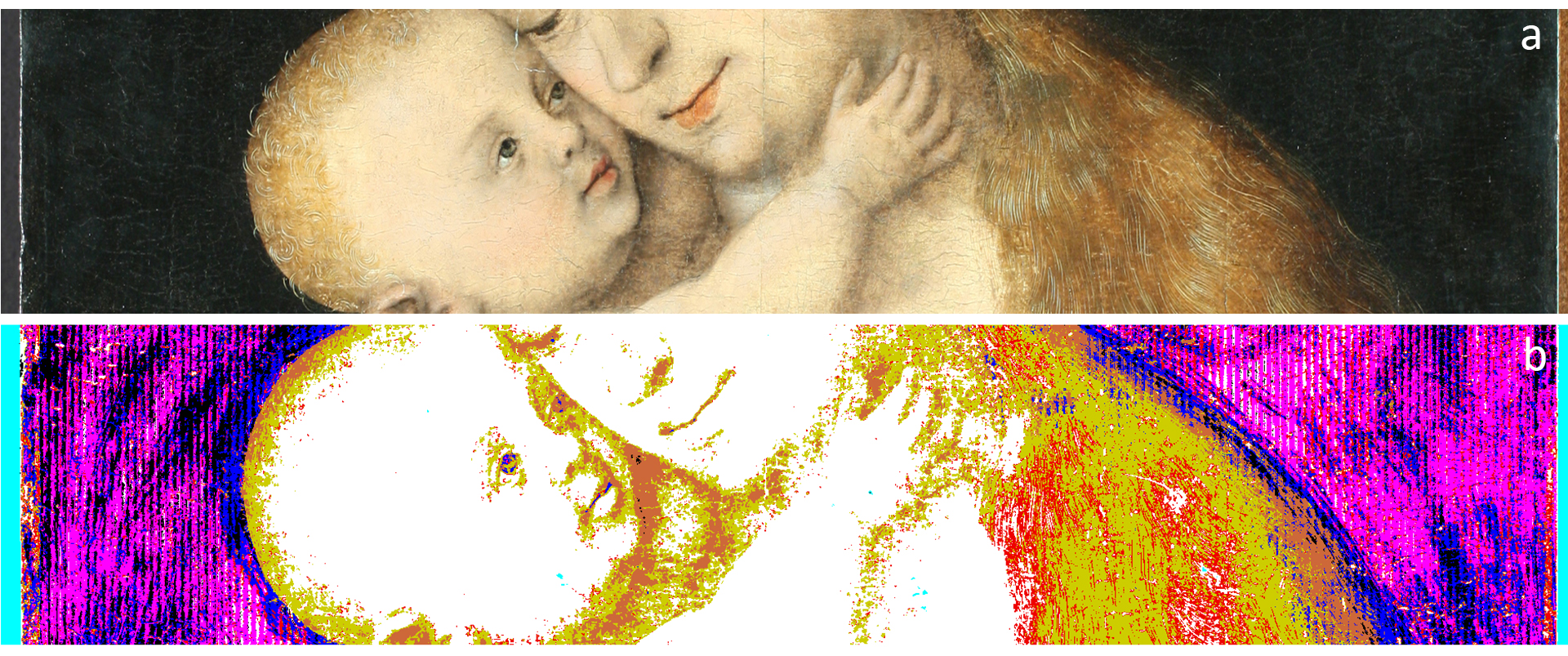PHASE 3 | 2022
Duration: 8 months
Summary report
The specific objective of the third phase of the INFRA-ART project was to develop an integrated pigment-mapping technique to reveal the distribution of components within a paint area or paint sample. According to the working plan, three tasks were carried out:
· Task 3.1 Testing and validation of developed algorithm on complex mixtures and artworks (Part II)
· Task 3.2 Development of semi-quantitative maps of pigment distributions
· Task 3.3 Depth profiling and sub-surface imaging investigations of multilayered works of art
Within Task 3.1, the development, testing, and validation of classification models obtained through multivariate analysis techniques were continued. The XRF data set obtained in the previous stage on the group of investigated earth pigments was used to develop and refine a classification model based on the chemical signature. The application of PCA on the XRF data marked some advantages when compared to direct spectral analysis, and it demonstrated a relatively good ability to discriminate between pigments of similar color but of different provenance. These results were included in a publication.
Classification models based on the PCA algorithm have also been tested on other classes of materials, including complex samples (mock-up samples created in the previous stage of the project and paint samples taken from various artworks). PCA exploratory models were developed based on several types of spectral data – XRF, FTIR, hyperspectral data, with mixed results in terms of data clustering. Improved results in the discrimination and classification of complex mixtures of pictorial materials could be obtained in the future by advanced pre-treatments of the datasets, and testing of different types of classification algorithms.
Task 3.2 aimed to develop an integrated pigment-mapping technique. An alternative approach to mapping pigments in paintings based on hyperspectral imagining combined with spectroscopic spot analysis was considered. This mapping approach was tested on both mock-up samples as well as on artworks (on selected painted areas). Data obtained from hyperspectral measurements were subjected to statistical methods. Several classification algorithms (spectral angle mapper, linear spectral unmixing, maximum likelihood) were tested in order to obtain the spatial distribution of the endmembers/pigments. The colour-coded hyperspectral maps generated, complemented by spectral spot analysis, provided in some of the cases an excellent overview of the distribution of pigments and allowed to better study the composition of mixtures, and to investigate specific effects such as shadowing or highlighting, or to investigate specific painting details with a high degree of precision.
In the last stage of the project, within Task 3.2, a series of case studies that included both archaeological samples (mural painting fragments) and works of art (easel paintings), were subjected to an in-depth analysis and data processing with the aim to identify and extract target information from both top surface layers (in-plane information) and sub-surface paint layers (sub-layers). To this aim, all artworks were previously investigated by a combined multi-analytical approach that included complementary spectroscopic techniques (XRF, FTIR, Raman) and high resolution imaging analysis such as hyperspectral imaging or digital radiography. The portfolio of case studies included Roman mural fragments from the collection of The National History Museum of Romania, and several easel paintings from private collections as well as from the collections of The National Museum of Art of Romania and Bucharest Municipality Museum. By integrating multiple spectral and imaging technique an extended view of the creative process and of the various materials that were originally used to produce a painting was achieved. Technical features (execution of the preparatory drawing), characteristic patterns (color palette, specific pigment mixtures) or typical fingerprints (chemical signature of the identified pigments) that may be used for attribution and forgery detection were analyzed, studied and discussed. The most representative results obtained on some of these case studies have been published or are about to be sent for publication.
Dissemination of the scientific results obtained was achieved by participation in a prestigious international conference (5th International Conference on Innovation in Art Research and Technology – inART 2022). One ISI article was published in the journal Minerals, and another paper was submited (currenlty under review) at Journal on Computing and Cultural Heritage. Other dissemination activities included the presentation of the INFRA-ART postdoctoral research project at the 14th European Exhibition of Creativity and Innovation (EUROINVENT 2022) that took place in Iași between 26-28 May 2020, the project being awarded a Silver Medal. A press article was also published in the June volume of Market Watch magazine that summarizes the main results achieved within the INFRA-ART project.

Results
Dissemination
Materials included within the INFRA-ART database
In this stage 222 new reference materials have been investigated via combined FTIR and XRF analysis. A preliminary dataset of Raman spectra have also been included. The INFRA-ART Spectral Library can be freely accessed online: https://infraart.inoe.ro/.

Case studies
>> Roman wall painting fragmnets (2nd–3rd century A.D, found at Ulpia Traiana Sarmizegetusa) from the collection of The National History Museum of Romania
>> Easel paintings from private collections as well as from the collections of The National Museum of Art of Romania and Bucharest Municipality Museum


